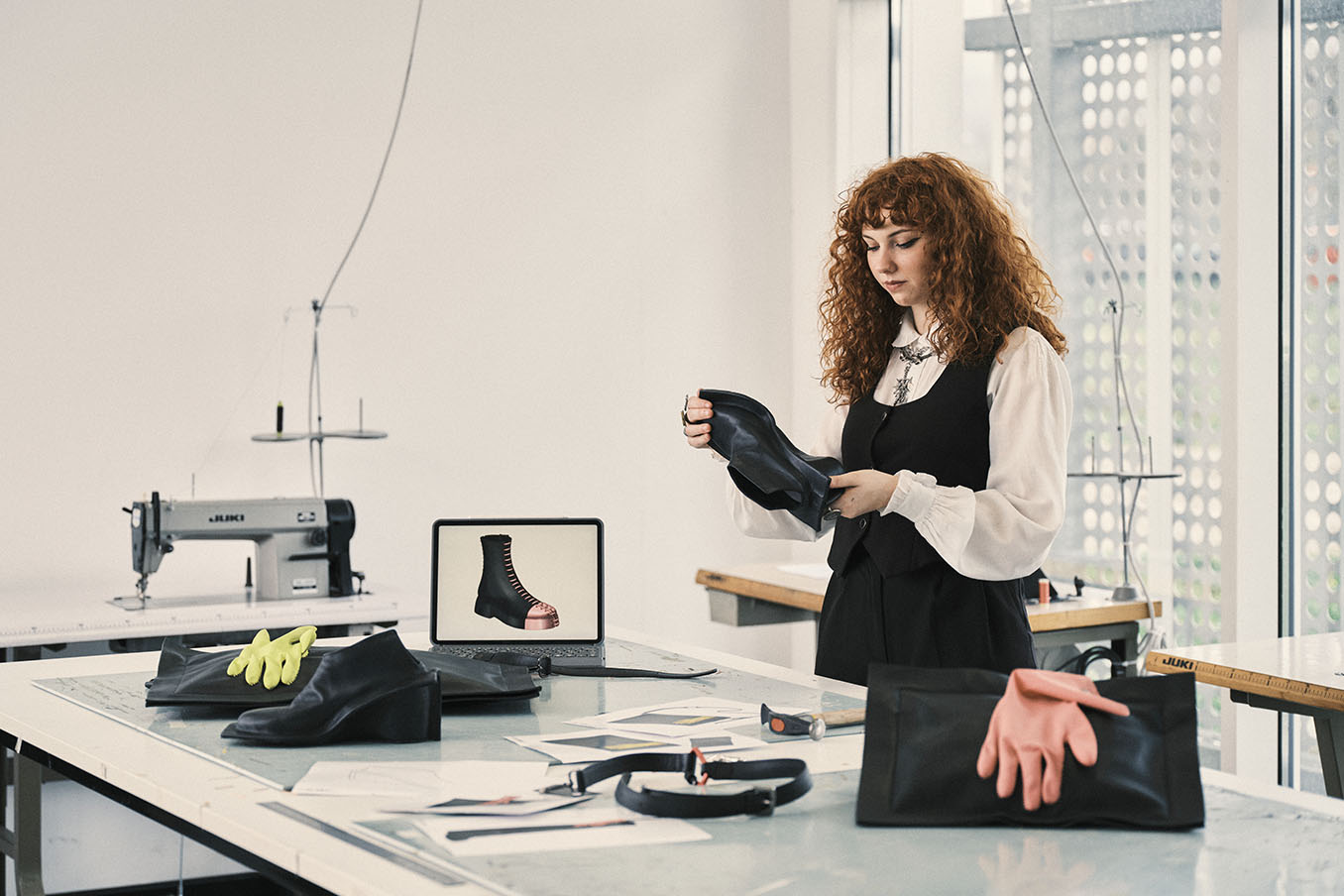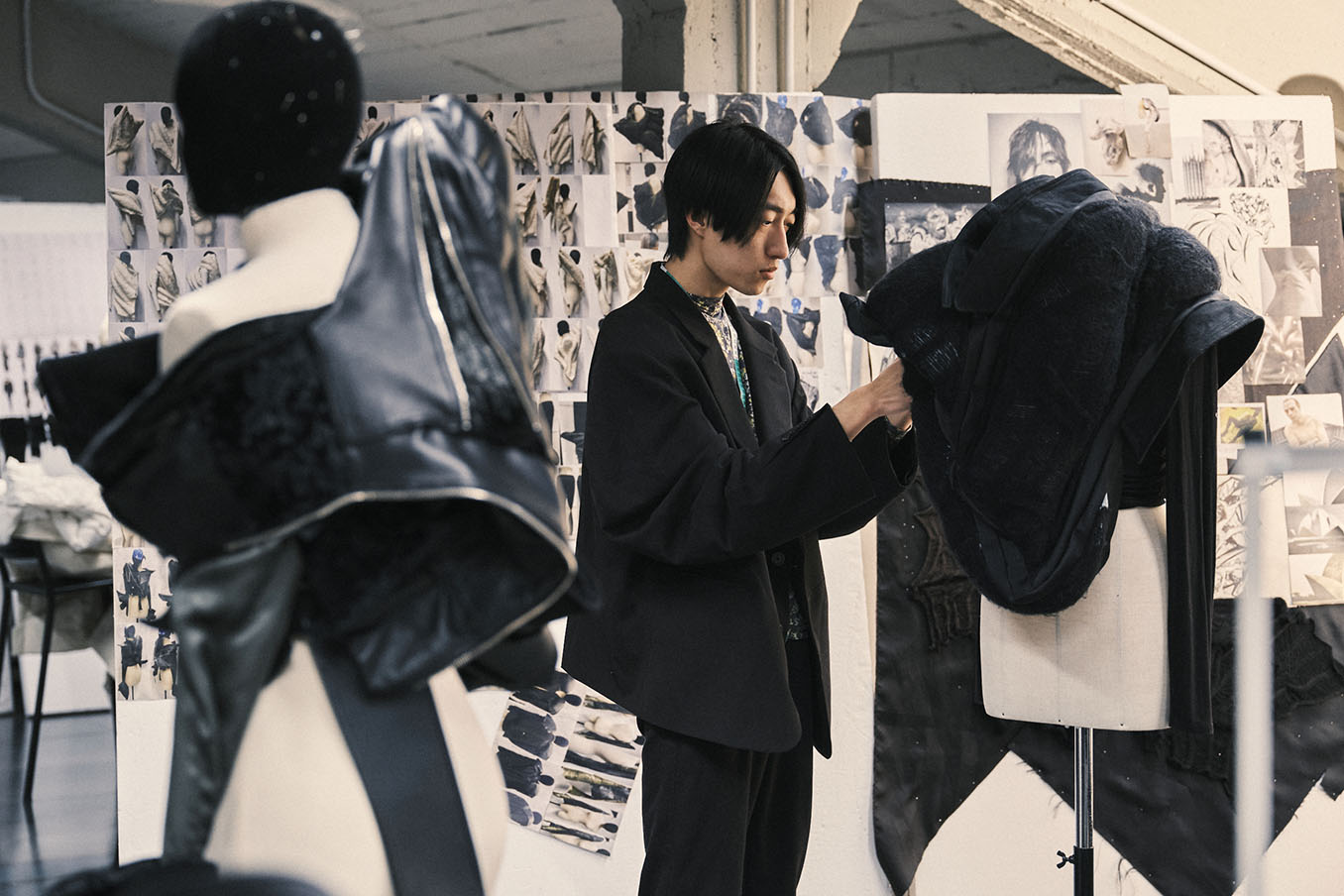Polimoda’s latest fashion graduates used personal and cultural narratives to authentically leave their mark in modern fashion. Fashion Roadman reports.
Fashion is always best in its most sincere form. In the current fashion landscape, revenue figures are king, and creativity is a by-stander to commerciality. Consumers are exhausted, designers are overworked, and critics have to find creative ways to make the same utterings. Massimiliano Giornetti, the current director of Polimoda shares the same frustration. “I think the focus on just numbers is killing the creativity in fashion,” he passionately exclaimed.
At a time when the fashion industry feels in dire need of revitalisation, the Polimoda students stepped forward, injecting it with the kind of imaginative lifeblood only emerging voices can offer.
From the very first click-clack of shoes on the runway, it was evident that threads of personal history, cultural inheritance, and narrative nuance had been meticulously woven into each look. The show opened with Silenzio Bianco, a collection by Nansen Capici, the deserving recipient of the “Best Collection 2025” accolade. Drawing inspiration from the Norwegian explorer Fridtjof Nansen, with whom he shares not just a name but a spirit of enquiry, Capici also channelled the architectural legacy of his paternal lineage, a family of architects whose influence subtly underpinned the collection’s sculptural forms.



Silhouettes echoed the dynamic posture of skiing, forward-leaning, aerodynamic, and braced against imagined Alpine gusts, a nod to Nansen’s pioneering role in modern ski culture. The tailoring, impressively precise, navigated the structural complexity of exaggerated shoulders and dense, weighty fabrics that paid homage to the Arctic landscape. Natural shearling, an evocative nod to the materials traditionally used by Norway’s Indigenous communities was employed with restraint and reverence, most strikingly in the “igloo bombers,” whose bold, rounded shapes referenced both architectural form and climate-defiant utility.
Yet, the pièce de résistance was a masterfully tailored faux-fur coat, sliced open at the back to reveal a zipped technical cotton shirt and sharply cut cotton gabardine ski overalls beneath. To create it, Capici manipulated thick fake fur with a heat gun, allowing it to shrink and warp in a controlled melt that created a degraded effect, directly referencing the textures and tones found in historical images of native Norwegians. It was a garment that blended innovation with memory, craft with concept and it rightly brought the house down.

Joseph Thomas Prince otherwise known as J.T. Prince breathed poignant nostalgia into his graduate collection Homecoming, a body of work sparked by a recent visit to his grandparents’ farm in Idaho, USA. As a child, he spent countless summers there, working on the farm and forging memories that would later become the emotional scaffolding of his designs. A recent visit, following the passing of his grandparents, stirred a quiet reflection that permeated the collection with depth and sentiment.



Pragmatic farm materials, such as tarpaulin, ubiquitous for everything from weed suppression to shielding crops were elevated into fashion contexts, grounding the work in personal history. This nostalgia extended beyond the agricultural: Prince referenced the oddly tender memory of new sofas swaddled in plastic, transforming that familiar domestic motif into skirts and footwear, all rendered with meticulous craftsmanship.
His eye for detail was particularly apparent in his replication of piping typically found on sofas and upholstered furniture reimagined across garments with finesse. Conceptual sophistication ran throughout, perhaps most cleverly in a hybrid garment that fused a jacket and dress, inspired by the poetic idea of a jacket lining bleeding into a dress. It was storytelling through silhouette in a subtle but clever way.
Sofia Sapena’s graduate collection took flight from a darkly humorous childhood memory. As a child, she once boarded a plane in what she described as an outfit consisting of a t-shirt and sweatpants, only to be met with her grandfather’s blunt remark: “Sofía, you’re getting on a plane, you might die and you’re dressed like that?” In that moment, she realised how differently generations perceive travel. For her grandfather, flying was a momentous occasion, one worthy of one’s best attire. For her, it was simply a means to an end.

This tension between reverence and nonchalance became the conceptual collection titled A Deadly Occasion. Her collection is a clever, irreverent, and unexpectedly poignant meditation on modern air travel and our tendency to take life’s most precarious acts (and flying among them) for granted. Sapena used the plane as both a literal and metaphorical symbol: a vessel through which to explore generational contrast, global crises, and the absurdities of daily life. As she pointed out, “we shampoo our hair, apply lipstick and scroll idly through our phones while war rages and economies collapse, business as usual, even as the world appears to teeter.”

This duality permeated the collection. A structured trouser was crafted from fabric reminiscent of airplane carpets, an ode to her grandfather’s imagined travel wardrobe. A life vest became a structured gilet and a thick wool coat referenced the stubborn bulk of overstuffed luggage. Perhaps most memorably, she riffed on those complimentary in-flight socks through a full-body knitted “sock suit” as both satire and homage.

Her grandfather’s daily uniform of suits and pressed shirts formed the backbone of the tailoring, but always with a Sapena-style twist. One standout piece, the towel jacket, was inspired by the texture of the feet of passengers walking down the aisle, an oddly tactile, almost grotesque translation of a shared travel experience. Elsewhere, a formal shirt was altered with internal leather cut-outs in the exact silhouette of a tank top worn underneath a nod to those visible outlines that subtly betray what lies beneath. In another look, the tank came in exoskeleton form.

Accessories played a vital role in the collection’s narrative. Sapena adorned jackets and shirts with badges bearing the logo of her fictional airline, Ayuda Airlines (ayuda is Spanish for help) a tongue-in-cheek branding exercise that added layers of satire and sincerity. She collaborated with bespoke Florentine eyewear label Herian to produce sleeping mask-inspired sunglasses, and partnered with Undergraduate in Fashion Accessories Design student Mandy Cheng on Instagram on bags that merged practicality with a playful touch. The accessories, murmured about with enthusiasm during the show, solidified her knack for world-building through detail.
In the end, Sapena delivered more than just a witty collection, she offered a sharply observed reflection on how we dress, how we travel, and how we cope with the chaos of modern life. It was humorous, heartfelt, and unnervingly accurate, a rare trifecta in fashion storytelling.

Grigory Fedenko’s graduate collection, Rise and Fall, grappled with the nature of power, its acquisition and its ostentation through a deeply considered lens. The collection split its conceptual axis between two pillars: the brutal ascent to power through resource extraction, and the theatrical display of power, as embodied by early 20th-century Russian militarism.
For the former, Fedenko turned to the petroleum industry, a grotesque emblem of modern power. He examined the geopolitical and environmental havoc wrought by crude oil: how the pursuit of its control has sparked wars, corrupted governments, and devastated ecosystems. Beneath the surface lies the poisoned soil of power, rich in profit, yet steeped in destruction.
To contrast this, the show of power was informed by the fall of Imperial Russia and the seismic shift to a Communist regime. In this historical pivot, Fedenko saw the symbolism of military dress where social standing was once signified by military rank, and it correlated with royal proximity.

Fedenko fused these threads, oil and empire, extraction and excess, into a collection that was as materially inventive as it was ideologically sharp. The garments bore the weight of industry, both literally and metaphorically. Half-dried epoxy appeared across outerwear, giving the garments a hardened, clay-like texture. Treated under intense heat and painted with a coating used on metal fences due to its resistance to extreme weather conditions, the finish resembled the toxic sheen of crude oil, its illusion so vivid you’d think it might stain you on contact (though mercifully, it doesn’t).
The technique was most strikingly deployed on a cocoon-shaped jacket, its silhouette echoing military uniforms worn by conscripts specifically referencing soldiers who had once attempted to forcibly enlist Fedenko into the army. The emotional resonance of the garment elevated its already impressive construction.

Elsewhere, industrial references continued. A structured jacket employed a “memory fabric” infused with metal, allowing it to retain dramatic, sculptural forms. An asymmetrical mini-dress featured raw hems and industrial snap closures, its roughness contrasting with the underlying precision of the cut. Throughout, Fedenko reimagined classical military tailoring with a brutal, post-industrial edge making the collection feel simultaneously historical and hyper-contemporary.
Scattered across the collections were accessories that felt less like finishing touches and more like bold statements, each one injecting a welcome jolt of originality into today’s increasingly homogenised fashion landscape. Sofia Sapena reimagined utility with a tongue-in-cheek twist, offering a triple mini-bag for men that cleverly subverted the idea of practicality in favour of playful excess. Meanwhile, JT Prince’s “couch” heels tapped into a particular strain of domestic nostalgia, evoking the oddly comforting memory of a freshly bought sofa, still wrapped in its crinkly plastic. The concept clearly struck a chord: clips of Prince discussing the shoes have amassed over 150,000 views across social media platforms.


Derin Kemer also drew attention with her sculptural corsetry, which was met with well-deserved praise. Her use of unconventional materials including intricately shaped wood showcased not only technical finesse but also a willingness to challenge expectations around structure, femininity and form.
Ultimately, Polimoda’s graduate show brought back the hope for fashion enthusiasts. This was reflected by the overwhelmingly favourable online reception. It was equally evident that the pedagogical approach was finely attuned to the demands of the industry. Tutors acted less as instructors and more as discerning mentors, guiding students in refining their conceptual frameworks while fostering a culture of rigorous collaboration. “Anyone can make a good collection,” Giornetti noted, “but sustaining a coherent vision and cultivating a recognisable design language is another matter entirely, that’s where our guidance comes in.”

As these impassioned and intellectually agile designers prepare to infiltrate the industry, to overlook their potential would be not just negligent, but strategically myopic. At a moment when fashion is gasping for reinvention, these creatives offer more than promise, they offer possibility. To exclude them from the future would be akin to refusing oxygen to a system in need of revival.
CREDITS
Written by:
- Odunayo Ojo, Fashion Roadman


